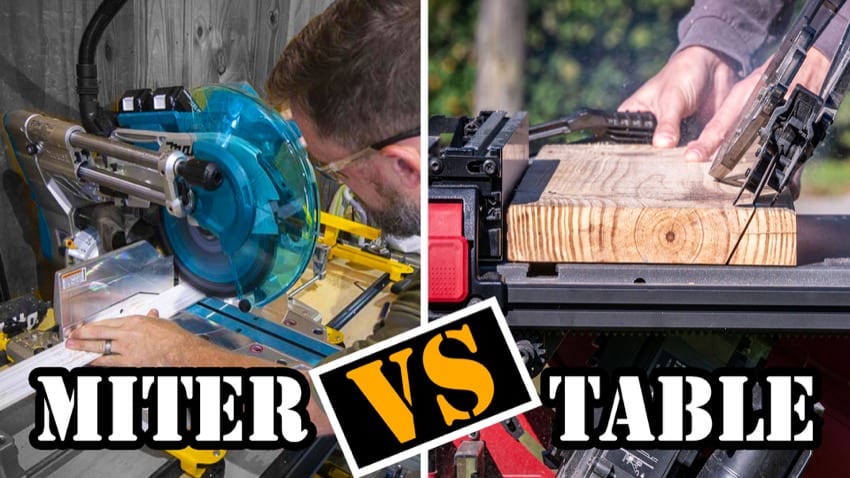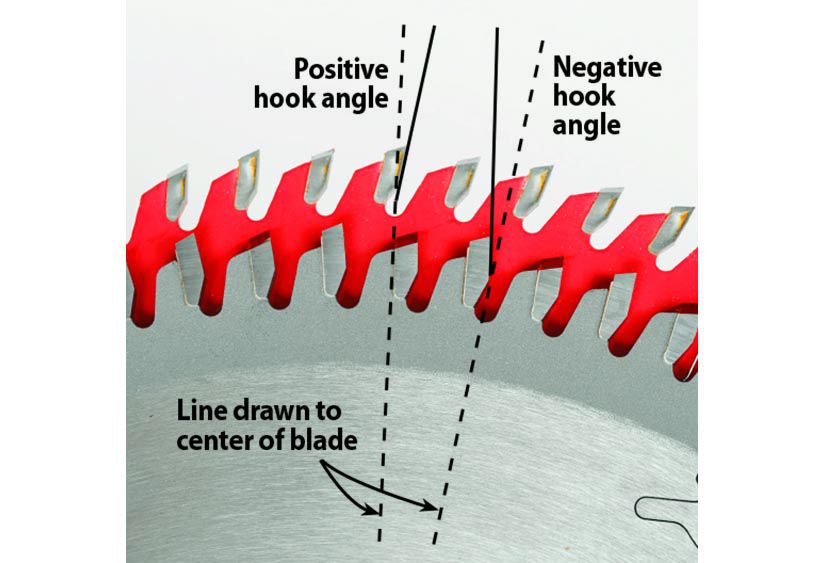Are miter saw and table saw blades interchangeable? If you’ve ever found yourself wondering about this, you’re in the right place! In this article, we’ll explore the topic and shed light on whether you can swap the blades between these two types of saws. So, let’s dive right in and find out the answer to this interesting question!
When it comes to woodworking, having the right tools for the job is essential. Both miter saws and table saws are commonly used for various cutting tasks. But can you use the blades interchangeably? Let’s uncover the truth in the next few paragraphs!
So, are miter saw blades and table saw blades interchangeable? Stay tuned as we delve into the similarities and differences between these two types of saws and their respective blades. Get ready to unlock the secrets of the workshop!

Are Miter Saw and Table Saw Blades Interchangeable?
Miter saws and table saws are popular power tools used in woodworking and carpentry projects. One question that often comes up is whether the blades for these two types of saws are interchangeable. In this article, we will explore the key differences between miter saw blades and table saw blades, discuss their compatibility, and provide some tips on choosing the right blade for your project.
Differences Between Miter Saw Blades and Table Saw Blades
Before we delve into whether the blades are interchangeable, let’s first understand the fundamental differences between miter saw blades and table saw blades.
Miter saw blades are specifically designed for making miter cuts and crosscuts at various angles. They typically have a large diameter and fewer teeth compared to table saw blades. Miter saw blades also feature a negative hook angle, which helps prevent kickback by reducing the aggressiveness of the cut. These blades are usually made for cutting through wood materials.
On the other hand, table saw blades are designed for ripping and crosscutting wood materials. They often have a higher tooth count and a smaller diameter compared to miter saw blades. Table saw blades usually have a positive or neutral hook angle, allowing for more aggressive cutting. They are versatile and can be used for a wide range of materials, including wood, plastic, and even metal with the appropriate blade.
Compatibility of Miter Saw Blades and Table Saw Blades
While there may be some overlap in the blades’ functionality, miter saw blades and table saw blades are generally not interchangeable. Here are a few reasons why:
- Size and Arbor: Miter saw blades have a larger diameter and a different arbor size compared to table saw blades. Attempting to use a miter saw blade on a table saw or vice versa can lead to improper alignment and potentially dangerous situations.
- Teeth and Tooth Geometry: Miter saw blades and table saw blades are designed with different tooth geometry to optimize their cutting performance for specific tasks. Using the wrong blade may result in subpar cuts and potential safety risks.
- Hook Angle: The hook angle of the blade affects the aggressiveness of the cut and can impact the level of control during the cutting process. Miter saw blades have a negative hook angle, while table saw blades typically have a positive or neutral hook angle.
While there may be some instances where you can use a miter saw blade on a table saw or vice versa, it is generally recommended to use the appropriate blade designed specifically for the intended tool and task.
Choosing the Right Blade for Your Project
When choosing a saw blade for your project, it’s essential to consider the type of cut you need to make, the material you’re working with, and the desired outcome. Here are some factors to consider:
- Blade Type: Determine whether you need a blade for a miter saw or a table saw based on the project requirements.
- Blade Size: Check the manufacturer’s recommendations for the appropriate blade size for your tool.
- Teeth Count: Consider the number of teeth on the blade. Higher tooth counts generally provide smoother cuts, while lower tooth counts allow for faster cutting.
- Tooth Geometry: Different tooth geometries are suitable for different materials. Choose a blade with the appropriate tooth geometry for your project.
- Blade Coating: Some blades come with special coatings that reduce friction and provide longer blade life.
Always prioritize safety when working with power tools. Make sure to read the manufacturer’s instructions and use the appropriate safety equipment for your specific task.
The Benefits of Using the Right Blade
Using the correct blade for your miter saw or table saw offers several benefits:
- Precision and Quality: The right blade will allow you to achieve cleaner and more accurate cuts, enhancing the overall quality of your work.
- Efficiency and Productivity: A well-suited blade will enhance cutting efficiency and improve your productivity, saving you time and effort.
- Safety: Using the appropriate blade reduces the risk of kickback and ensures safer operation.
- Longevity: Proper blade selection and usage will help extend the life of your blades, saving you money in the long run.
Conclusion:
While miter saw blades and table saw blades may have some similarities, they are generally not interchangeable due to differences in size, tooth geometry, and hook angles. It is crucial to use the appropriate blade for your specific tool and task to achieve the best results and ensure safety. Take the time to choose the right blade for your project, considering factors such as blade size, teeth count, and tooth geometry. By using the correct blade, you’ll optimize your cutting performance and enhance the quality of your woodworking projects.
Key Takeaways: Are Miter Saw and Table Saw Blades Interchangeable?
- Miter saw and table saw blades are not interchangeable.
- Miter saw blades have a higher tooth count for smoother cuts.
- Table saw blades have a lower tooth count for faster cuts.
- Miter saw blades have a smaller diameter compared to table saw blades.
- It is important to use the correct blade for each type of saw for optimal performance and safety.
Frequently Asked Questions
Are you wondering if miter saw blades can be used interchangeably with table saw blades? We’ve got you covered with these answers to some commonly asked questions!
1. Can I use a miter saw blade on a table saw?
While it may be tempting to use a miter saw blade on a table saw, it’s generally not recommended. Miter saw blades are specifically designed for crosscutting, meaning they excel at making smooth cuts across the grain. Table saw blades, on the other hand, are designed for ripping and making cuts along the grain. They have a different tooth geometry, typically featuring flat-topped teeth, which allows for efficient chip removal during long rip cuts. Using a miter saw blade on a table saw may result in poor performance, tear-out, and potential safety hazards.
If you find yourself needing to make crosscuts on a table saw, it’s best to invest in a good-quality table saw crosscutting sled or a dedicated crosscutting blade. These tools are specifically designed to ensure safe and accurate crosscuts on a table saw.
2. Can I use a table saw blade on a miter saw?
While it may be possible to use a table saw blade on a miter saw, it’s not recommended for several reasons. Table saw blades are typically larger in diameter compared to miter saw blades, which can affect the performance and safety of your miter saw. Additionally, table saw blades often have a wider kerf (the width of material removed during a cut) compared to miter saw blades, which can result in less accurate and more wasteful cuts on a miter saw. Furthermore, table saw blades may not have the same level of precision and stability required for precise miter cuts.
To ensure optimal performance and safety, it’s best to use a miter saw blade specifically designed for your miter saw. These blades are engineered to deliver clean and accurate miter cuts, making your woodworking tasks much easier and more efficient.
3. What are the key differences between miter saw blades and table saw blades?
Miter saw blades and table saw blades have several key differences. The most notable difference is in their tooth geometries. Miter saw blades typically have a high tooth count, ranging from 60 to 100 or more. They feature alternating bevel tooth geometry, which allows for clean crosscuts on various materials. Table saw blades, on the other hand, have fewer teeth, usually ranging from 24 to 50. They have a flat-top or alternate top bevel tooth geometry, which is optimized for ripping cuts along the grain.
Another significant difference is in the size and mounting configuration. Miter saw blades are generally smaller in diameter, ranging from 8 to 12 inches, and they typically have a 5/8-inch arbor hole. Table saw blades, on the other hand, are larger, ranging from 10 to 12 inches or more, and they usually have a 5/8-inch or 1-inch arbor hole.
4. Can I use a general-purpose blade for both miter saw and table saw?
While a general-purpose blade can be used on both a miter saw and a table saw, it’s important to consider the limitations and trade-offs. General-purpose blades are designed to handle a variety of cutting tasks and materials with moderate efficiency. They are a compromise between the specific tooth geometries and configurations needed for optimized performance on a miter saw or table saw.
If you frequently perform specific types of cuts on either a miter saw or a table saw, it’s recommended to invest in dedicated blades for each. This way, you can achieve the best possible results and ensure safe and efficient cutting operations.
5. Can I swap blades between a miter saw and a table saw if the arbor size matches?
In general, it’s not recommended to swap blades between a miter saw and a table saw, even if the arbor size matches. Despite matching arbor hole sizes, the different tooth geometries, sizes, and overall configurations of miter saw blades and table saw blades can significantly impact the performance, accuracy, and safety of the tool. It’s always best to use blades specifically designed for the intended tool to achieve the optimal results.
Swapping blades between tools can lead to inferior cuts, poor performance, increased risk of kickback, and potential damage to both the blades and the tools themselves. To ensure the best woodworking experience and results, it’s advisable to use the right blade for the right tool.

Summary
So, to wrap things up, miter saw and table saw blades are not interchangeable. They are designed differently and serve different purposes. Miter saw blades have a higher tooth count for making precise and clean crosscuts, while table saw blades have larger teeth for ripping through material efficiently. You should always use the right blade for the right tool to achieve the best results and ensure safety. Remember, safety should always come first when working with power tools!
